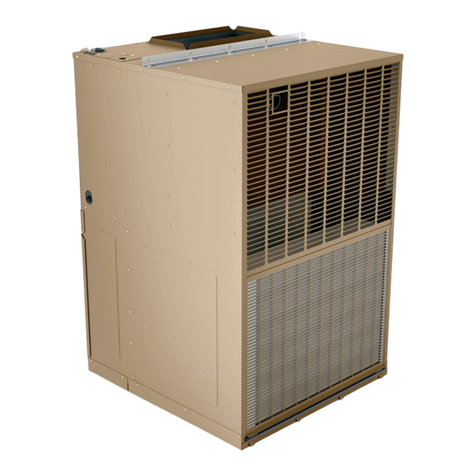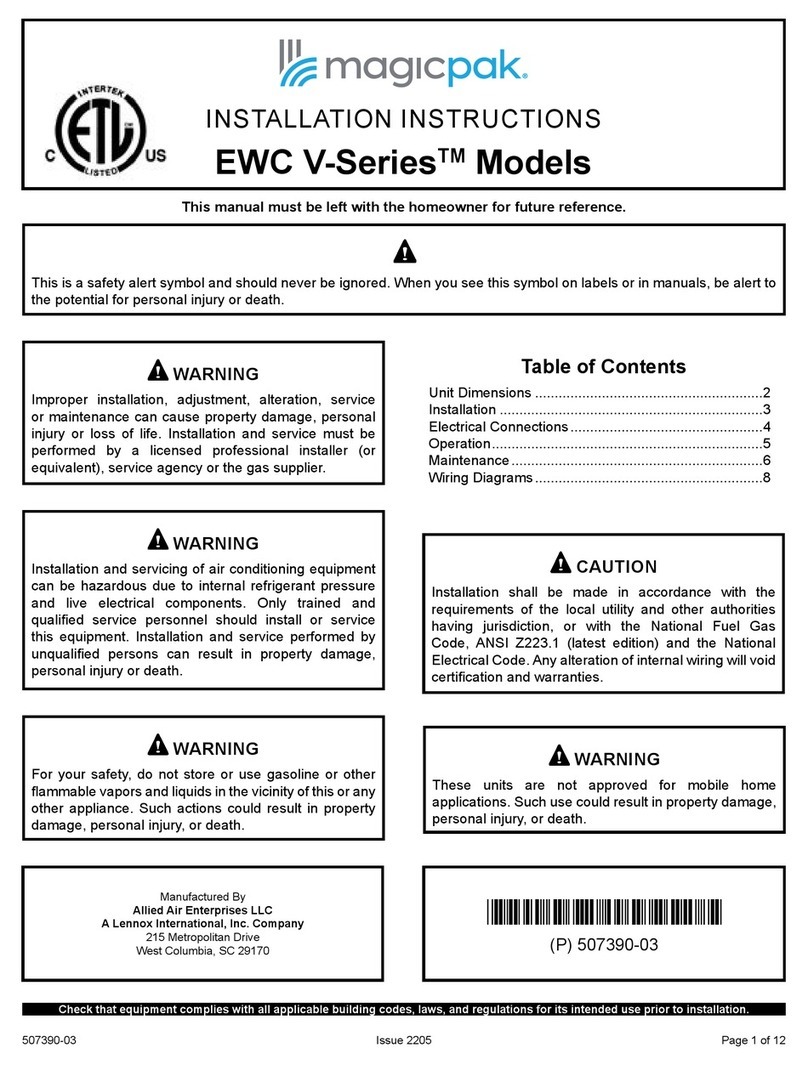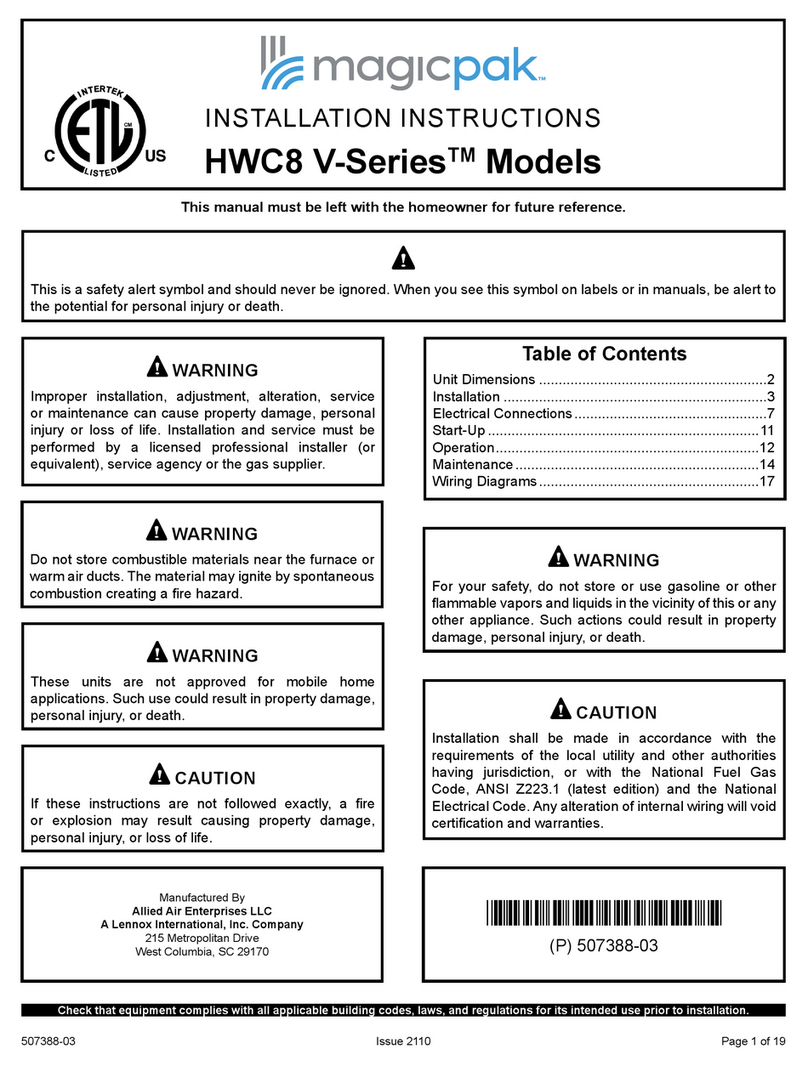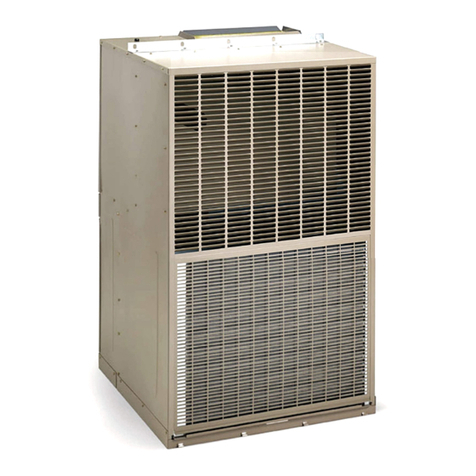
506326-01 Page 5 of 20Issue 0941
Venting
The venting system is an integral part of the appliance. The
ventingsystem must notbe modified inany matter otherthan
what is specified in these instructions.
This appliance should be installed in a location such that
the vent outlet is located in the following manner:
1. Distances to windows that open, building openings, or
public walkways should be consistent with the National
Fuel Gas Code Z223.1 or CAN/CGA-B149.1 & .2.
2. ForU.S. installations,the vent systemshall terminate a
minimumhorizontalclearance of4'fromelectricmeters,
regulators, and relief equipment. For installations in
Canada, refer to the current CAN/CGA-B149.1 & .2 or
with the authorities having local jurisdiction.
3. Flue products from properly adjusted and maintained
units, will not cause degradation to building materials.
The unit contains an exhaust blower. The blower draws the
combustionproductsoutoftheheatexchanger together with
dilutionairand forces themixturefromtheunit to the outside.
No special provisions are required for supplying air for
combustion, nor is a chimney required.
Theventoutletmustbeextended(seeVent Pipe Installation
on page 6).
Theventing systemisdesignedforproperoperationunder all
weatherconditionsandforwindsup to 40 miles per hour,and
should be unobstructed for a minimum of 2 feet.
Existing Venting Systems
When an existing furnace is removed and replaced, the
MGE4unit ventingsystemmay nolongerbe sizedtoproperly
vent the attached appliances. An improperly sized venting
system can result in spillage of flue products into the living
space, the formation of condensate, leakage, etc. Refer to
the WARNING box in the next column for proper test
procedure.
Failure to follow the steps outlined below for each
appliance connected to the venting system being
placed into operation could result in carbon monoxide
poisoning or death.
Thefollowing stepsshall befollowedforeachappliance
connected to the venting system being placed into
operation, while all other appliances connected to the
common venting system are not in operation:
1. Seal any unused openings in the common venting
system.
2. Visually inspect the venting system for proper size
andhorizontalpitch,asrequiredintheNationalFuel
GasCode,ANSIZ223.1/NFPA54(latestedition) or
the CSA B149.1, Natural Gas and Propane
InstallationCodesandtheseinstructions.Determine
that there is no blockage or restriction, leakage,
corrosion, or other deficiencies which could cause
an unsafe condition.
3. As far as practical, close all building doors and
windows between the space in which the
appliance(s) connected to the venting system are
located and other spaces in the building.
4. Close fireplace dampers.
5. Turn on clothes dryers and any appliance not
connected to the venting system. Turn on any
exhaustfans, such as range hoodsandbathroom
exhausts, so they are operating at maximum
speed. Do not operate a summer exhaust fan.
6. Followthelighting instructions.Placethe unitbeing
inspected in operation. Adjust the thermostat so
applianceis operating continuously.
7. Testforspillagefromdrafthoodequippedappliances
at the draft hood relief opening after
5 minutes of main burner operation. Use the flame
of a match or candle.
8. If improper venting is observed during any of the
above tests, the venting system must be corrected
in accordance with the National Fuel Gas Code,
ANSIZ223.1/NFPA54(latestedition)and/ortheCSA
B149.1, Natural Gas and Propane Installation
Codes.
9. After it has been determined that each appliance
remainingconnectedtotheventingsystemproperly
vents when tested as outlined above, return doors,
windows,exhaustfans,fireplacedampers,andany
other gas-fired burning appliance to their previous
conditions of use.
CARBON MONOXIDE POISONING HAZARD
WARNING
The sleeve is not intended as the sole support for the
unit.An additionalsupportmust beprovidedforadequate
support (see Figure 2).
CAUTION






























